
Fjellborg Vikings
Viking Age Locks:
Style 4a - Bolt removal by spring depression on chests and doors.
The Locks on this page would use these styles of keys:

Lock Bolt with attached Spring.
An experiment using sperate components found in the Mastermyr toolbox.
While examining the Mastermyr toolbox collection archeological drawings for inspiration in making replicas for our Viking age reenactment group, I spotted something that seemed like there was another style of lock unnoticed until now.. In none of the writings about the Mastermyr toolbox are found any correlation of the component parts. Using Photoshop, I joined two objects, a key and a locks ward plate from the collection and saw they were related as the key fits the ward plate exactly.


 To the left you see the ward plate. It is designed to permit the keys 4 "teeth" to enter after the key is passed through the keyway on the right of the plate.
To the left you see the ward plate. It is designed to permit the keys 4 "teeth" to enter after the key is passed through the keyway on the right of the plate.
On the left also, you see the key with 4 teeth, which fits the plate. These illustrations to the left are not to scale here.
We also need to look at the detail of the lock's ward plate. To the right/above is a close up of the top edge of the ward plate where you can see it has a rolled edge that is cut out directly above the key-tooth cutouts. For the sliding bolt's springs to work independently, the spring/bolt would move vertically to the illustration. There was were I realized the connection to other parts in the collection.
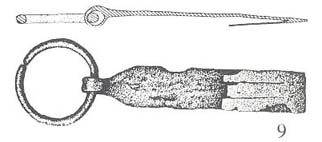 There are two flat spring ended objects with large rings on one end, hammered thin with spring "fingers" folded back upon itself. They are listed as lock parts. The spring plates DO NOT belong to the lock set as they have the wrong number of spring fingers, three instead of four but with a little photo manipulation, I can show how with a 4 finger spring plate the three components create a complete working lock.
There are two flat spring ended objects with large rings on one end, hammered thin with spring "fingers" folded back upon itself. They are listed as lock parts. The spring plates DO NOT belong to the lock set as they have the wrong number of spring fingers, three instead of four but with a little photo manipulation, I can show how with a 4 finger spring plate the three components create a complete working lock.
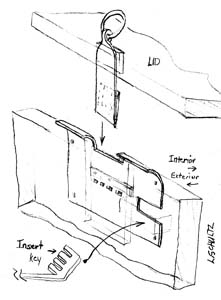
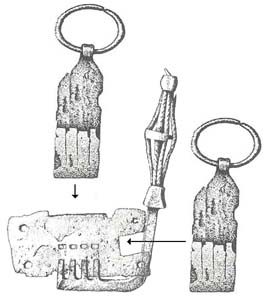
To the left we now see how the three parts may have worked together. What is not evident in the drawings, would be a catch that would hold the sprung-bolt in place until the key's teeth would depress the springs to release the sprung-bolt. The catch would be located just above the 4 holes made for the key's teeth, illustrated by the horizontal line pointing to it's location. After the key released the bolt, the user would lift the lid by the ring.
Importantly, the exterior view of the chest would show no evidence of the lock other than the wooden keyway. The lid would not have an exposed hasp but rather only the lift ring would project outside the lid. Before mounting the ward plate to the interior, a shallow recess would be carved on the inside to form a channel for the spring hasp to slide.
Like the lock illustrated above, there are only three parts to the lock, and the key to make it work. Another effective but simple Viking age lock.
I also might expect the installed lock hasp would have further reinforcement on the lid to strengthen the wood around the ringed grip.
It is worth noting that there are three examples of this style lock within the Mastermyr tool box parts, the ward plate for a four toothed key and spring ended, ringed bolts for two sperate three toothed key locks.
Documentation:
A discription of this style and others can be found in "Anglo-Scandinavian Ironwork from Coppergate" by Patrick Ottaway. 284pp, 160 illustrations ISBN: 978 1 872414 29 4
York Archaeological Trust The Trust is well known for its investigations of the deeply stratified and well-preserved urban archaeological deposits of historic York, some of which led to the creation of JORVIK, the world renowned Viking centre.
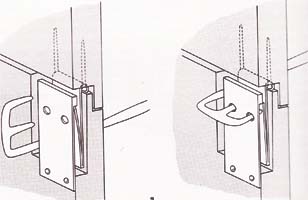
To the left you see a drawing from the book showing how the locks finction.
4 Birka Locks of similar Design with the Lock Bolt with attached spring:
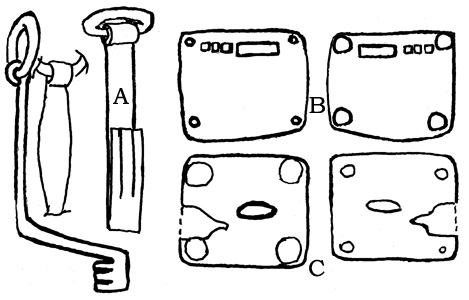
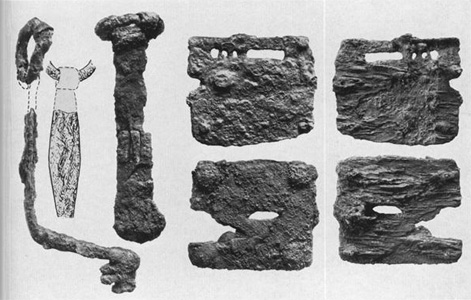
There seems to be more locks of the "overlooked Mastermyr locks" style within the collection of grave goods from the Birka Chamber Burials of the 10th Century. Not only does this lock on the left have the ward plate, removable bolt with attached three finger spring but also the original three toothed key. The lock set is complete!
To the right is a simplified rendering of the parts. These are to scale to each other. First you see the key and the second illustration is another perspective of the key's handle. Next you see the sprung bolt with a pull ring on the top (A). The lock's ward plate, ("B" - Top object with 3 small and 1 large rectangular holes.) would be located INSIDE the chest, as the three key-tooth holes need to be hidden from view. It is shown as, front and back view.
Lastly, below the ward plate is the exterior keyway plate or "keyhole escutcheon" (C). Though the rusted artifact seems to have a lens-like opening, I believe this is caused by the irregularity of the rust, not the actual hole and the x-rayed hole would be shown to be rectangular like the one in the ward plate.
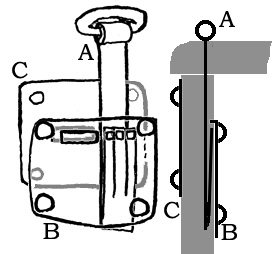
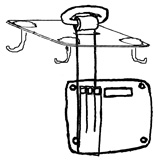
I did consider the second, lower plate (C) might be reinforcement for the lid, as a retainer for the ringed bolt. I do not believe this was the case as they would have rusted together in the burial unless the chest would have been left open. Not likely at all. More likely, is the second plate is the keyway plate for the exterior of the chest, as illustrated in the drawing to the right.
As the illustration on the right shows, these parts are very compatible and form a complete lock set.
At this point I am certain both locks (above) work as illustrated here. Another interesting point is the Mastermyr, from Southern Norway and the Birka chamber grave are distant enough in time and local that this style may be common as a chest lock style. Further examination of photos of the Birka Camber Grave shows three more of this type (below). Leastwise, we do have seven examples total.
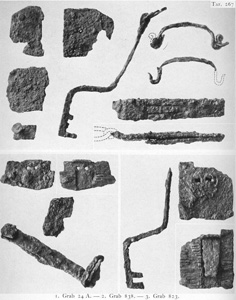
In the photo to the left there are three sperate lock sets illustrated. The three upper left objects are the remains of the ward plate and keyhole escutcheon, Then you find a three toothed key and two views of the three fingered spring/bolt with pull-ring. This set includes TWO (?) handles. This might indicate handles on the ends of the box. If so, that would be the first of this feature known to Viking age chests. Unknown is wether this was a residential box or a sea chest. I prefer to assume the first.
In the second set on the bottom left half of the photo you will find the ward plate, front view and back and the sprung bolt with pull-ring. Lastly on the lower right in the photo we have a two toothed key, ward plate key entry side and the ward plate interior view with the remains of the sprung-bolt.
Return to Viking Age Locks
 There are two flat spring ended objects with large rings on one end, hammered thin with spring "fingers" folded back upon itself. They are listed as lock parts. The spring plates DO NOT belong to the lock set as they have the wrong number of spring fingers, three instead of four but with a little photo manipulation, I can show how with a 4 finger spring plate the three components create a complete working lock.
There are two flat spring ended objects with large rings on one end, hammered thin with spring "fingers" folded back upon itself. They are listed as lock parts. The spring plates DO NOT belong to the lock set as they have the wrong number of spring fingers, three instead of four but with a little photo manipulation, I can show how with a 4 finger spring plate the three components create a complete working lock.



 To the left you see the ward plate. It is designed to permit the keys 4 "teeth" to enter after the key is passed through the keyway on the right of the plate.
To the left you see the ward plate. It is designed to permit the keys 4 "teeth" to enter after the key is passed through the keyway on the right of the plate.






